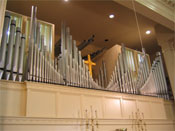Articles and Writings

Trinity Presbyterian Church
You're considering a combination digital/pipe organ…. Now what?
Legend states Al Harrah created the first combination electronic/pipe organ in Atlanta, Georgia in the
1970's. Since then, they have rapidly grown in popularity until now it is even uncommon to see an instrument by an
all-pipe organ builder that doesn’t include digital 32' pedal stops. While various organizations such as ISO & APOBA
have stated policies on digital voices, they stop short of explaining themselves.
1 - Tuning
While all combination instruments have some sort of sensor for the digital voices to track the tuning of the pipes as they change with changes in temperature, not all digital voices are created equally. Many digital organ makers intentionally build their stops out of tune. You heard right, these brand new digital voices are out of tune with themselves which then makes the task of your skilled pipe organ service firm all but impossible. As organ builders, there are few tasks we can take pride in like leaving a pipe organ in really excellent tune. When the digital voices are out of tune with themselves, it is then impossible for us to make the organ sound good.
So you've hired an excellent firm to design and voice the pipes for your new instrument. Do they also voice/regulate the digital voices? If not, is the showroom dealer you purchased the electronic voices from qualified to do so? So much of how an organ sounds is not in the individual voices but in their blend. While blend and contrast are relatively easy for a pipe organ builder to do, when you are dealing with digital voices sampled from another instrument with its own design and acoustic, it can be quite difficult to alter those 'sampled' voices to match your needs.
Your new digital voices are sampled from a 1921 E. M. Skinner organ. Your pipe organ was built by a local tracker organ builder in the 1960's. Even with electric actions on your slider windchest, and even if revoiced, these pipes will speak differently than pipes on an electro-pneumatic windchest. There is nothing you can do to make these pipes respond in the same manner or even at the same speed. As there are no moving parts involved with a digital organ, unless your slider windchest is perfectly regulated the digital voices can often play slightly ahead of your pipe organ. This is not a deficiency in the pipe organ, but rather an aspect that makes the pipe organ sound the way it does. The type of chest the pipes are placed on directly impacts their attack and tone. With no way to sample the chest action in your digital voices they and your pipes may never agree.
Often times, the firm selling your digital voices have no experience with pipe organs, and vice versa. As with all mechanical devices, all organs require service and maintenance and rare is the firm who is expertly versed in digital as well as pipe organs. So what happens when you have a problem such as a dead note on the pipe organ? Well the pipe organ company comes out, makes an inspection to discover the problem is with the relay installed by the digital organ company and they can not work on it. Of course, the reverse is possible as well, but the point is with a combination instrument you are often times beholden to two firms for the service of your organ and unless the two communicate closely they could in theory work against each other.
